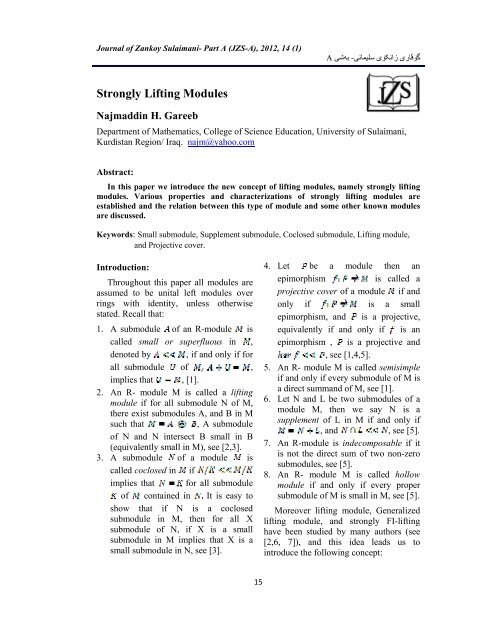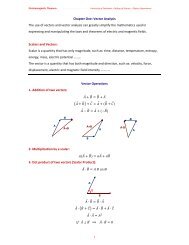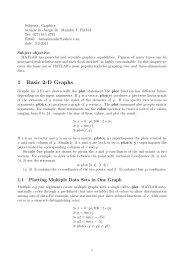Strongly Lifting Modules - University of Sulaimani
Strongly Lifting Modules - University of Sulaimani
Strongly Lifting Modules - University of Sulaimani
You also want an ePaper? Increase the reach of your titles
YUMPU automatically turns print PDFs into web optimized ePapers that Google loves.
Journal <strong>of</strong> Zankoy <strong>Sulaimani</strong>- Part A (JZS-A), 2012, 14 (1)<br />
گۆڤاری زانکۆی سليمانی- بهشی A<br />
<strong>Strongly</strong> <strong>Lifting</strong> <strong>Modules</strong><br />
Najmaddin H. Gareeb<br />
Department <strong>of</strong> Mathematics, College <strong>of</strong> Science Education, <strong>University</strong> <strong>of</strong> <strong>Sulaimani</strong>,<br />
Kurdistan Region/ Iraq. najm@yahoo.com<br />
Abstract:<br />
In this paper we introduce the new concept <strong>of</strong> lifting modules, namely strongly lifting<br />
modules. Various properties and characterizations <strong>of</strong> strongly lifting modules are<br />
established and the relation between this type <strong>of</strong> module and some other known modules<br />
are discussed.<br />
Keywords: Small submodule, Supplement submodule, Coclosed submodule, <strong>Lifting</strong> module,<br />
and Projective cover.<br />
Introduction:<br />
Throughout this paper all modules are<br />
assumed to be unital left modules over<br />
rings with identity, unless otherwise<br />
stated. Recall that:<br />
1. A submodule <strong>of</strong> an R-module is<br />
called small or superfluous in ,<br />
denoted by , if and only if for<br />
all submodule <strong>of</strong> ,<br />
implies that , [1].<br />
2. An R- module M is called a lifting<br />
module if for all submodule N <strong>of</strong> M,<br />
there exist submodules A, and B in M<br />
such that<br />
, A submodule<br />
<strong>of</strong> N and N intersect B small in B<br />
(equivalently small in M), see [2,3].<br />
3. A submodule <strong>of</strong> a module is<br />
called coclosed in if<br />
implies that for all submodule<br />
<strong>of</strong> contained in It is easy to<br />
show that if N is a coclosed<br />
submodule in M, then for all X<br />
submodule <strong>of</strong> N, if X is a small<br />
submodule in M implies that X is a<br />
small submodule in N, see [3].<br />
4. Let be a module then an<br />
epimorphism<br />
is called a<br />
projective cover <strong>of</strong> a module if and<br />
only if is a small<br />
epimorphism, and is a projective,<br />
equivalently if and only if is an<br />
epimorphism , is a projective and<br />
, see [1,4,5].<br />
5. An R- module M is called semisimple<br />
if and only if every submodule <strong>of</strong> M is<br />
a direct summand <strong>of</strong> M, see [1].<br />
6. Let N and L be two submodules <strong>of</strong> a<br />
module M, then we say N is a<br />
supplement <strong>of</strong> L in M if and only if<br />
, and , see [5].<br />
7. An R-module is indecomposable if it<br />
is not the direct sum <strong>of</strong> two non-zero<br />
submodules, see [5].<br />
8. An R- module M is called hollow<br />
module if and only if every proper<br />
submodule <strong>of</strong> M is small in M, see [5].<br />
Moreover lifting module, Generalized<br />
lifting module, and strongly FI-lifting<br />
have been studied by many authors (see<br />
[2,6, 7]), and this idea leads us to<br />
introduce the following concept:<br />
15
Journal <strong>of</strong> Zankoy <strong>Sulaimani</strong>- Part A (JZS-A), 2012, 14 (1)<br />
گۆڤاری زانکۆی سليمانی- بهشی A<br />
§1 strongly lifting module:<br />
In this section we introduce the new<br />
definition namely strongly lifting module<br />
and we will prove that every strongly<br />
lifting module is lifting module but the<br />
converse is not true in general, for this<br />
purpose we give an example, moreover in<br />
this section we give a necessary condition<br />
to become lifting module a strongly<br />
lifting. Also we prove that the direct<br />
summand <strong>of</strong> a strongly lifting modules is<br />
strongly lifting module.<br />
Definition 1.1: An R-module M is called<br />
a strongly lifting R-module, if for each<br />
submodule N <strong>of</strong> M, N is either summand<br />
or small.<br />
Proposition 1.2: Every strongly lifting R-<br />
module M is a lifting R-module.<br />
Pro<strong>of</strong>: for all N submodule <strong>of</strong> an R-<br />
module M, since M is a strongly lifting R-<br />
module so either , or N is a<br />
summand <strong>of</strong> M. If , then always<br />
there exists a trivial submodule 0 as a<br />
directed summand <strong>of</strong> M, that is<br />
where 0 is in N and<br />
, hence in this case<br />
we can say M is a lifting module. But if N<br />
is a direct summand <strong>of</strong> M, then there<br />
exists a submodule T in M such that<br />
, and clearly N is a<br />
submodule <strong>of</strong> itself and<br />
which is always small in M.<br />
Thus M is a lifting module<br />
Note. The following example shows that a<br />
lifting module needs not be a strongly<br />
lifting module.<br />
Example 1.3: Consider M=Z 12 as a Z-<br />
module, then it is clear that Z 12 has only<br />
the following submodules:<br />
( )={ },<br />
( )= Z 12 =M,<br />
( )={ , , , },<br />
( ) = { },<br />
( ) = { },<br />
( ) = { }.<br />
Table 1: bellow shows that which two<br />
submodules <strong>of</strong> M span M.<br />
+ ( ) ( ) ( ) ( ) ( ) ( )<br />
( ) M<br />
( ) M M M M M M<br />
( ) M M<br />
( ) M M M<br />
( ) M M<br />
( ) M<br />
Table 2: bellow shows that which two<br />
submodules <strong>of</strong> M forms a direct<br />
summand <strong>of</strong> M.<br />
⊕ ( ) ( ) ( ) ( ) ( ) ( )<br />
( ) M<br />
( ) M<br />
( )<br />
( ) M<br />
( ) M<br />
( )<br />
Now to show that M is a lifting module<br />
for all N submodule <strong>of</strong> M, we have to<br />
show that there exist submodules K, and<br />
K ’ in M such that<br />
in N<br />
and . For there<br />
exist submodules ( ), and M in M such<br />
that<br />
) in ( ), and<br />
. For<br />
there exist submodules ( ), and ( ) in M<br />
such that , (see table 2),<br />
( ) in ( ), and ∩ = which is<br />
small in M (see table 1). For<br />
there exist submodules ( ), and ( ) in M<br />
such that , (see table 2),<br />
( ) in ( ), and .<br />
For N= ( ) there exist submodules ( ),<br />
and ( ) in M such that M = ( ) ⊕ ( ),<br />
16
Journal <strong>of</strong> Zankoy <strong>Sulaimani</strong>- Part A (JZS-A), 2012, 14 (1)<br />
گۆڤاری زانکۆی سليمانی- بهشی A<br />
(see table 2), ( ) in ( ), and ( ) ( ) = ( )<br />
Journal <strong>of</strong> Zankoy <strong>Sulaimani</strong>- Part A (JZS-A), 2012, 14 (1)<br />
گۆڤاری زانکۆی سليمانی- بهشی A<br />
Pro<strong>of</strong>. Let<br />
be a module<br />
epimorphism with M1 strongly lifting<br />
module. To show that M2 is also a<br />
strongly lifting module, let N be any<br />
submodule <strong>of</strong> M2, we must prove that N<br />
is summand <strong>of</strong> M2 or small in M2. We<br />
know that (N) is a submodule <strong>of</strong> M1,<br />
but M1 is a strongly lifting module so<br />
(N) is a summand or small in M1. If<br />
(N) is summand <strong>of</strong> M1 then there<br />
exists a submodule say B in M1 such that:<br />
(N)<br />
hence , but<br />
one can easily show that:<br />
Moreover we have f epimorphism hence:<br />
, which means that N<br />
is summand <strong>of</strong> M2. In other hand if<br />
(N) is small in M1, then by Lemma<br />
1.6; ), but this<br />
implies that (since is an<br />
epimorphism), hence M2 is a strongly<br />
lifting module<br />
Corollary 2.2: If M is a strongly lifting<br />
module, then so is M/N for all submodule<br />
N <strong>of</strong> M.<br />
Pro<strong>of</strong>. Since there exists a natural<br />
epimorphism<br />
then by<br />
using above proposition the pro<strong>of</strong><br />
becomes clear<br />
Proposition 2.3: If is an epimorhpism<br />
from any module P on to a strongly lifting<br />
module M and<br />
, then P is<br />
also strongly lifting module.<br />
Pro<strong>of</strong>. For simplicity let , then<br />
from the fundamental theorem <strong>of</strong><br />
isomorphism we have P/K isomorphic to<br />
M, and hence P/K is a strongly lifting<br />
module. Now to prove P is strongly lifting<br />
module let N be any submodule <strong>of</strong> P, we<br />
must show that N is summand <strong>of</strong> P or<br />
small in P. Since P/K is a strongly lifting<br />
module, so<br />
is summand <strong>of</strong><br />
P/K, or small in P/K. If<br />
is<br />
summand <strong>of</strong> P/K, then there exists a<br />
submodule say<br />
, where K is<br />
a submodule <strong>of</strong> K’, and K’ is a submodule<br />
<strong>of</strong> P, such that:<br />
but<br />
this implies that:<br />
, by<br />
assumption , so<br />
and this means that N is a<br />
summand <strong>of</strong> P. But if<br />
is small<br />
in P/K, then we claim that for all<br />
submodule U <strong>of</strong> P the equation N+U=P<br />
implies that . We know<br />
implies that: ,Or<br />
,<br />
but<br />
is small in P/K, hence<br />
, or equivalently<br />
but by assumption<br />
P. Thus . therefore<br />
N is small in P<br />
Corollary 2.4: Let K be any small<br />
submodule <strong>of</strong> an R-module M, then M is a<br />
strongly lifting module if M/K is a<br />
strongly lifting module.<br />
Pro<strong>of</strong> . Is trivial<br />
Corollary 2.5: If f is an epimorhpism<br />
from a module P on to a module M and<br />
, then P is strongly lifting if<br />
and only if M is a strongly lifting module.<br />
Pro<strong>of</strong>. Is clear (since we can deduce this<br />
pro<strong>of</strong> from 2.1 and 2.3)<br />
Proposition 2.6: Every semisimple<br />
module is a strongly lifting module.<br />
Pro<strong>of</strong>. Is clear<br />
The converse <strong>of</strong> propostion 2.6 is not true<br />
in general as we see in Z 4 as Z- module.<br />
Note we denote by Rad(M) the radical <strong>of</strong><br />
a module M.<br />
18
Journal <strong>of</strong> Zankoy <strong>Sulaimani</strong>- Part A (JZS-A), 2012, 14 (1)<br />
گۆڤاری زانکۆی سليمانی- بهشی A<br />
Corollary 2.7:<br />
(1) Every submodule <strong>of</strong> a semisimple<br />
module is a strongly lifting module.<br />
(2) Every epimorphic image <strong>of</strong> a<br />
semisimple module is a strongly<br />
lifting module.<br />
(3) The sum <strong>of</strong> semisimple modules is a<br />
strongly lifting module.<br />
(4) If R is a semisimple ring then every R-<br />
module is a strongly lifting module.<br />
(5) If every right and left R-module is<br />
injective, then R is a semisimple ring<br />
and M is a strongly lifting module.<br />
(6) If every right and left R-module is<br />
projective, then R is a semisimple ring<br />
and M is a strongly lifting module.<br />
(7) If every simple right R-module and<br />
every simple left R-module is<br />
projective, then R is a semisimple ring<br />
and M is a strongly lifting module.<br />
(8) If every submodule <strong>of</strong> M has a<br />
supplement in M, and<br />
then M is a strongly lifting module.<br />
(9) Let be a projective cover <strong>of</strong><br />
M, then P is a strongly lifting module<br />
if an only if M is a strongly lifting<br />
module.<br />
(10) If M is artinian module, and<br />
then M is a strongly<br />
lifting module.<br />
(11) If M is artinian, then M/Rad(M) is a<br />
strongly lifting module .<br />
Pro<strong>of</strong>. All the pro<strong>of</strong>s are trivial<br />
The following corollary gives a necessary<br />
and sufficient condition for a strongly<br />
lifting module to be a semisimple module:<br />
Corollary 2.8: Let M be a non- zero R-<br />
module which has unique small<br />
submodule, then M is a semisimple if and<br />
only if M is a strongly lifting module.<br />
Pro<strong>of</strong>. The pro<strong>of</strong> is trivial<br />
Proposition 2.9: Every hollow module is<br />
a strongly lifting module<br />
Pro<strong>of</strong>. The pro<strong>of</strong> is obvious<br />
The converse <strong>of</strong> the above proposition is<br />
not true in general as we see in Z 6 as Z-<br />
module.<br />
Corollary 2.10:<br />
(1) Every cyclic module which has unique<br />
maximal submodule is a strongly<br />
lifting module.<br />
(2) Let M be a module, if every non-zero<br />
factor module <strong>of</strong> M is indecomposable<br />
then M is a strongly lifting module.<br />
(3) Every local module is a strongly<br />
lifting module.<br />
(4) If in a module M, we have Rad M, is a<br />
small and maximal, then M is a<br />
strongly lifting module.<br />
(5) If P is a projective module, and<br />
indomorphism <strong>of</strong> P: End(P) is a local<br />
ring then P is a strongly lifting<br />
module.<br />
(6) If P is a projective cover for a simple<br />
module then P is a strongly lifting<br />
module.<br />
(7) If L is a supplement <strong>of</strong> a maximal<br />
submodule N in module M then L is a<br />
strongly lifting module.<br />
Pro<strong>of</strong>. Since each <strong>of</strong> the above cases gives<br />
a hollow module, so by proposition 2.9,<br />
the pro<strong>of</strong> becomes clear<br />
Proposition 2.11: Every non-zero<br />
coclosed submodule <strong>of</strong> a strongly lifting<br />
module is also strongly lifting module.<br />
Pro<strong>of</strong>. Let N be a non-zero coclosed<br />
submodule <strong>of</strong> a strongly lifting module M.<br />
We must prove that N is a strongly lifting<br />
module for this purpose suppose that L is<br />
any submodule <strong>of</strong> N, then L is a<br />
submodule <strong>of</strong> M, but M is a strongly<br />
lifting module, hence , or L<br />
summand <strong>of</strong> M. If , and since N<br />
is coclosed in M, so Moreover, if<br />
L is a summand <strong>of</strong> M, then there exists L’<br />
in M such that .Now<br />
, by<br />
19
Journal <strong>of</strong> Zankoy <strong>Sulaimani</strong>- Part A (JZS-A), 2012, 14 (1)<br />
گۆڤاری زانکۆی سليمانی- بهشی A<br />
modular law<br />
, and this<br />
means that L is a summand <strong>of</strong> N, therefore<br />
N is a strongly lifting module<br />
Corollary 2.12: Every supplement<br />
submodule <strong>of</strong> a strongly lifting module is<br />
also a strongly lifting module.<br />
Pro<strong>of</strong>. The pro<strong>of</strong> is obvious<br />
References:<br />
[1] Kasch F., <strong>Modules</strong> and Rings, Acad. Press, London.<br />
[2] Payman Mahmood, Hollow <strong>Modules</strong> and Semihollw <strong>Modules</strong>, M.sc. Thesis,<br />
<strong>University</strong> <strong>of</strong> Baghdad, (2005).<br />
[3] Anderson F.W. and Fuller K.R., Rings and Categories <strong>of</strong> modules, Springer-Verlag,<br />
NewYork, (1992).<br />
[4] Keskin D. and Lomp C., On Special lifting modules, Controlled Mathematic,<br />
(2000).<br />
[5] Keskin D., On lifting modules, Comm. Algebra , 28 (7), 3427-3440, (2000).<br />
[6] Y. Talebi and T. Amoozegar, <strong>Strongly</strong> FI-lifting modules, International Electronic<br />
Journal <strong>of</strong> Algebra, 3, 75-82, (2008).<br />
[7] Yongduo Wang and Nanqing Ding, Generalized lifting <strong>Modules</strong>, International<br />
Journal <strong>of</strong> Mathematics and Mathematical Sciences , 1-9, Article ID 47390, (2006).<br />
20
Journal <strong>of</strong> Zankoy <strong>Sulaimani</strong>- Part A (JZS-A), 2012, 14 (1)<br />
گۆڤاری زانکۆی سليمانی- بهشی A<br />
@@<br />
@@Žïèói@ñòìòŠóØŒŠói@ðÝî†íà<br />
@@‡ïÉ@ó¼@kî‹Ì@ó¼@æî‡Üa@â−<br />
@@N×aÈMçbn†ŠíØ@ôºŠóèMôäbáïÝ@ñüÙäaŒ@LçbØóïnäaŒ@ò†ŠòìŠóq@ðvïÜüØ@LÚïmb¸bà@ð’ói<br />
@@ón‚íq<br />
@ïèói@õòìòŠóØŒŠói@ôÝŽî@†üà õìbäói@òìòŠóØŒŠói@ðÝŽî@†üàüi@ììŠ@ómün‚@çbáŽîíä@õóØûi@óáï÷@a†óîòìóåî‰îím@ãóÜ<br />
@óè@ì@óÝŽî†üà@òŠüu@ãó÷@çaíŽïä@õ‡äòíîóq@òì@LŽïèói@õòìòŠóØŒŠói@ðÝŽî†üà@üi@ò솋Ø@o슆@çbà@bïu@bïu@ñòìòŠóØ@bïu@ì@pbÑï<br />
@@@Nòìa‹ØŠó@óÜ@õòìóåïÜüÙŽïÜ@ìa‹bä@õ‹m@ôÝŽî†üà@ÚŽî‡ä<br />
@@@õíÕÜa@ÊÐa‹Üa@‘bÕ¾a<br />
@@‡ïÉ@ó¼@kî‹Ì@ó¼@æî‡Üa@â−<br />
@@N×a‹ÉÜaMçbn†‹Ø@âïÝÔc@MóïäbáïÝÜa@óÉàbu@LóîíiÜa@ãíÝÉÜa@óïÝØ@Lpbïšbî‹Üa@âÔ<br />
@@ó–þ©a<br />
@aí©a@båäíØ@‡ÕÜ@NõíÕÜa@ÊÐa‹Üa@‘bÕ¾a@âa@o¥@ÊÐa‹Üa@Hßíî†í¾aI@‘bÕáÝÜ@a‡î‡u@bàíéÑà@‹Ø‰ä@Óí@LszjÜa@a‰è@À@<br />
@õ‹‚ýa@pýíî†í¾a@Éi@ì@ßíî†í¾a@æà@ËíåÜa‰è@μi@óÔþÉÜa@bå“Ôbäì@LñíÕÜa@ÊÐa‹Üa@Hpýíî†í¾aI@pbbÕáÝÜ@óÑÝn¬@païá¾aì<br />
@@@NóÐì‹É¾a<br />
21

















